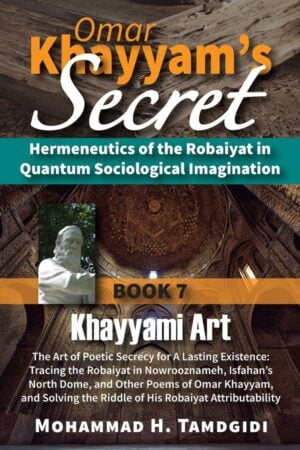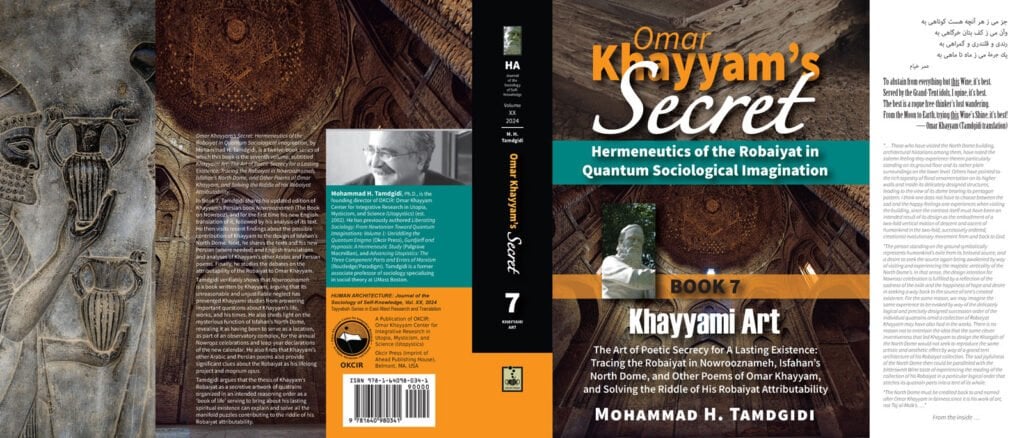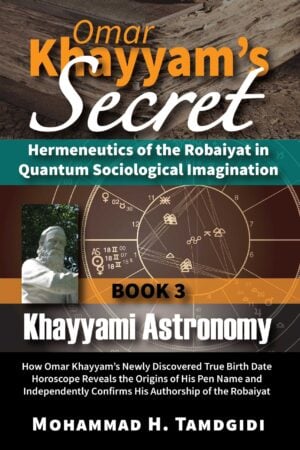Omar Khayyam’s Secret: Hermeneutics of the Robaiyat in Quantum Sociological Imagination: Book 7: Khayyami Art: The Art of Poetic Secrecy for a Lasting Existence: Tracing the Robaiyat in Nowrooznameh, Isfahan’s North Dome, and Other Poems of Omar Khayyam, and Solving the Riddle of His Robaiyat Attributability
$69.99 – $119.00
Omar Khayyam’s Secret: Hermeneutics of the Robaiyat in Quantum Sociological Imagination, by Mohammad H. Tamdgidi, is a twelve-book series of which this book is the seventh volume, subtitled Khayyami Art: The Art of Poetic Secrecy for a Lasting Existence: Tracing the Robaiyat in Nowrooznameh, Isfahan’s North Dome, and Other Poems of Omar Khayyam, and Solving the Riddle of His Robaiyat Attributability, Each book, independently readable, can be best understood as a part of the whole series. In this 7th of his 12-book Omar Khayyam’s Secret series, M. H. Tamdgidi explores the Robaiyat in Nowrooznameh, Isfahan’s North Dome, Khayyam’s other poems, and the riddle of attributability of the Robaiyat to Khayyam.
Publication Date: March 1, 2024
Note: The ePub ebook edition of this title (ISBN: 9781640980365) can be purchased from major online ebook stores worldwide.

All the sections of this publication can be read online by logged-in members of the OKCIR Library with a valid access. In that case click on any section in the table of contents below, and then click on the large PDF icon at the bottom of that page to access the publication section. Alternatively, you can purchase this publication as offered below.
Description
Omar Khayyam’s Secret: Hermeneutics of the Robaiyat in Quantum Sociological Imagination
Book 7: Khayyami Art
The Art of Poetic Secrecy for a Lasting Existence: Tracing the Robaiyat in Nowrooznameh, Isfahan’s North Dome, and Other Poems of Omar Khayyam, and Solving the Riddle of His Robaiyat Attributability
Author: Mohammad H. Tamdgidi
Publication Date: March 1, 2024
Human Architecture: Journal of the Sociology of Self-Knowledge (ISSN: 1540-5699)
Volume XX, 2024, Monograph Series: Tayyebeh Series in East-West Research and Translation
Description
Omar Khayyam’s Secret: Hermeneutics of the Robaiyat in Quantum Sociological Imagination, by Mohammad H. Tamdgidi, is a twelve-book series of which this book is the seventh volume, subtitled Khayyami Art: The Art of Poetic Secrecy for a Lasting Existence: Tracing the Robaiyat in Nowrooznameh, Isfahan’s North Dome, and Other Poems of Omar Khayyam, and Solving the Riddle of His Robaiyat Attributability. Each book, independently readable, can be best understood as a part of the whole series.
In Book 7, Tamdgidi shares his updated edition of Khayyam’s Persian book Nowrooznameh (The Book on Nowrooz), and for the first time his new English translation of it, followed by his analysis of its text. He then visits recent findings about the possible contribution of Khayyam to the design of Isfahan’s North Dome. Next, he shares the texts, and his new Persian (where needed) and English translations and analyses of Khayyam’s other Arabic and Persian poems. Finally he studies the debates about the attributability of the Robaiyat to Omar Khayyam.
Tamdgidi verifiably shows that Nowrooznameh is a book written by Khayyam, arguing that its unreasonable and unjustifiable neglect has prevented Khayyami studies from answering important questions about Khayyam’s life, works, and his times. Nowrooznameh is primarily a work in literary art, rather than in science, tasked not with reporting on past truths but with creating new truths in the spirit of Khayyam’s conceptualist view of reality. Iran in fact owes the continuity of its ancient calendar month names to the way Khayyam artfully recast their meanings in the book in order to prevent their being dismissed (given their Zoroastrian roots) during the Islamic solar calendar reform underway under his invited direction. The book also sheds light on the mysterious function of Isfahan’s North Dome as a space, revealing it as having been to serve, as part of an observatory complex, for the annual Nowrooz celebrations and leap-year declarations of the new calendar. The North Dome, to whose design Khayyam verifiably contributed and in fact bears symbols of his unitary view of a world created for happiness by God, is the ground zero of the world’s most accurate solar calendar. It deserves to be named after Omar Khayyam (not Taj ol-Molk) and declared as a cultural world heritage site. Nowrooznameh is also a pioneer in the prince-guidance books genre that anticipated the likes of Machiavelli’s The Prince by centuries, the difference being that Khayyam’s purpose was to inculcate his Iranian and Islamic love for justice and the pursuit of happiness in the young successors of Soltan Malekshah. Iran is famed for its ways of converting its invaders into its own culture, and Nowrooznameh offers a textbook example for how it was done by Khayyam.
Most significantly, however, Nowrooznameh offers by way of its intricately multilayered meanings the mediating link between Khayyam’s philosophical, theological, and scientific works, and his Robaiyat, showing through metaphorical clues of his beautiful prose how his poetry collection could bring lasting spiritual existence to its poet posthumously. Khayyam’s other Arabic and Persian poems also provide significant clues about the origins, the nature, and the purpose of the Robaiyat as his lifelong project and magnum opus.
Tamdgidi argues that the thesis of Khayyam’s Robaiyat as a secretive artwork of quatrains organized in an intended reasoning order as a ‘book of life’ serving to bring about his lasting spiritual existence can solve the manifold puzzles contributing to the riddle of his Robaiyat attributability. He posits, and in the forthcoming volumes of this series will demonstrate, that the lost quatrains comprising the original collection of Robaiyat have become extant over the centuries, such that we can now reconstruct, by way of solving their 1000-piece jigsaw puzzle, the collection as it was meant to be read as an ode of interrelated quatrains by Omar Khayyam.
About the Author
Mohammad H. Tamdgidi, Ph.D., is the founding director and editor of OKCIR: Omar Khayyam Center for Integrative Research in Utopia, Mysticism, and Science (Utopystics) and its journal, Human Architecture: Journal of the Sociology of Self-Knowledge (ISSN: 1540-5699), which have served since 2002 to frame his independent research, pedagogical, and publishing initiatives. He is a former associate professor of sociology specializing in social theory at UMass Boston and has taught sociology at SUNY-Binghamton and SUNY-Oneonta.
Besides his currently in progress work published in the 12-book series Omar Khayyam’s Secret: Hermeneutics of the Robaiyat in Quantum Sociological Imagination (Okcir Press), Tamdgidi has previously authored Liberating Sociology: From Newtonian Toward Quantum Imaginations: Volume 1: Unriddling the Quantum Enigma (2020, Okcir Press), Gurdjieff and Hypnosis: A Hermeneutic Study (2009, Palgrave Macmillan), and Advancing Utopistics: The Three Component Parts and Errors of Marxism (2007, Routledge/Paradigm). He has published numerous peer reviewed articles and chapters and edited more than thirty journal issues.
Tamdgidi holds a Ph.D. and M.A. in sociology in conjunction with a graduate certificate in Middle Eastern studies from Binghamton University (SUNY). He received his B.A. in architecture from U.C. Berkeley, following enrollment as an undergraduate student of civil engineering in the Technical College of the University of Tehran, Iran.
His areas of scholarly and practical interest are the sociology of self-knowledge, human architecture, and utopystics-three fields of inquiry he invented in his doctoral studies and has since pursued as respectively intertwined theoretical, methodological and applied fields of inquiry altogether contributing to what he calls the quantum sociological imagination. His research, teaching, and publications have been framed by an interest in understanding how world-historical social structures and personal selves constitute one another. This line of inquiry has itself been a result of his longstanding interest in understanding the underlying causes of failures of the world’s utopian, mystical, and scientific movements in bringing about a just global society.

Omar Khayyam’s Secret: Hermeneutics of the Robaiyat in Quantum Sociological Imagination: Book 7: Khayyami Art: The Art of Poetic Secrecy for a Lasting Existence: Tracing the Robaiyat in Nowrooznameh, Isfahan’s North Dome, and Other Poems of Omar Khayyam, and Solving the Riddle of His Robaiyat Attributability
Published by: Okcir Press (an imprint of Ahead Publishing House) • Belmont, Massachusetts
First Edition: March 1, 2024, published on the ninth centennial of Omar Khayyam’s passing (AD 1123)
826 pages • 6×9 inches • Includes figures, references, and index
Library of Congress Control Number (LCCN): 2024902158
ISBN: 9781640980341 (hard cover with dust jacket: alk. paper)
ISBN: 9781640980358 (soft cover: alk. paper)
ISBN: 9781640980365 (ePub ebook)
ISBN: 9781640980372 (PDF ebook)
CITATION: Tamdgidi, Mohammad H. 2024. Omar Khayyam’s Secret: Hermeneutics of the Robaiyat in Quantum Sociological Imagination: Book 7: Khayyami Science: Khayyami Art: The Art of Poetic Secrecy for a Lasting Existence: Tracing the Robaiyat in Nowrooznameh, Isfahan’s North Dome, and Other Poems of Omar Khayyam, and Solving the Riddle of His Robaiyat Attributability. Human Architecture: Journal of the Sociology of Self-Knowledge. Vol. XX, 2024. Tayyebeh Series in East-West Research and Translation.) Belmont, MA: Okcir Press.
Where to Purchase this Book: The various editions of this volume can be ordered from the Okcir Store and all major online bookstores worldwide (such as Amazon, Barnes&Noble, Google Play, Apple, and others).

Table of Contents
Omar Khayyam’s Secret: Hermeneutics of the Robaiyat in Quantum Sociological Imagination: Book 7: Khayyami Art: The Art of Poetic Secrecy for a Lasting Existence: Tracing the Robaiyat in Nowrooznameh, Isfahan’s North Dome, and Other Poems of Omar Khayyam, and Solving the Riddle of His Robaiyat Attributability
Published to Date in the Series—ii
About the Author—viii
Acknowledgments—xxi
Preface to Book 7: Recap from Prior Books of the Series—1
Introduction to Book 7: Tracing the Robaiyat in Omar Khayyam’s Artwork—11
1] Introduction–21
2] The Persian Text of Omar Khayyam’s Treatise “Nowrooznameh” (The Book on Nowrooz): An Updated Edition Based on the Berlin Manuscript (Used in Its Mojtaba Minovi Edition and Also in Its Ali Hasouri Edition) and the Partial London and Other Manuscripts (Used in Its Edition by Rahim Rezazadeh Malek)–45
3] New English Translation of Omar Khayyam’s Treatise “Nowrooznameh” (The Book on Nowrooz)–90
A. Introduction of the Book, Nowrooznameh–92
B. On the Customs of Persian Kings–101
C. The Arrival of the Priest of Priests and the Offering of Newroozi Gifts–104
D. The High Acclamation of the Priest of Priests in Their Own Expression–104
E. Speaking of the Gold and What is Necessary to Be Said About It–105
F. Signs of the Buried Treasures–107
G. Speaking of the Ring and What is Necessary to Be Said About It–109
H. Speaking of the Budding Barley Grain and What is Necessary to Be Said About It–113
I. Speaking of the Sword and What is Necessary to Be Said About It–115
J. Speaking of the Bow and Arrow and What Is Necessary to be Said About Them–117
K. Speaking of the Pen and Its Attribute, and What Is Necessary to Be Said About It–121
L. Speaking of the Horse, Its Art, and What Is Necessary to Be Said About It–126
M. Names of Horses in the Persian Language–128
N. Speaking of the Falcon, and of Its Art, and What is Necessary About It–129
O. On Selecting a Falcon–130
P. Stories About the Benefits of the Wine–131
Q. Story About the Meaning of the Origin of Wine–135
R. A Speech on the Attribute of the Beautiful Face–138
4] Conclusion–142
CHAPTER II– Omar Khayyam’s Literary Work “Nowrooznameh”: A Clause-by-Clause Textual Analysis—147
1] Introduction–147
2] The Opening Lines and Clause 1 of “Nowrooznameh”–148
A. Introduction of the Book, Nowrooznameh–154
B. On the Customs of Persian Kings–197
C. The Arrival of the [Zoroastrian] Priest of Priests and the Offering of Nowroozi Gifts–215
D. The High Acclamation of the [Zoroastrian] Priest of Priests in Their Own Expression–217
E. Speaking of the Gold and What is Necessary to Be Said About It–223
F. Signs of the Buried Treasures–230
G. Speaking of the Ring and What is Necessary to Be Said About It–240
H. Speaking of the Budding Barley Grain and What is Necessary to Be Said About It–249
I. Speaking of the Sword and What is Necessary to Be Said About It–255
J. Speaking of the Bow and Arrow and What Is Necessary to be Said About Them–261
K. Speaking of the Pen and Its Attribute, and What Is Necessary to Be Said About It–270
L. Speaking of the Horse, Its Art, and What Is Necessary to Be Said About It–296
M. Names of Horses in the Persian Language–300
N. Speaking of the Falcon, and of Its Art, and What is Necessary to Be Said About It–303
O. On Selecting a Falcon–305
P. Stories About the Benefits of the Wine–308
Q. Story About the Meaning of How Wine Was Created–319
R. A Speech on the Attribute of the Beautiful Face–327
3] Conclusion–343
1] Introduction–367
2] The Twenty-Year Reign of Soltan Malekshah and His Commission to Build an Astronomical Observatory in Isfahan to Reform Iran’s Solar Calendar–369
3] What Nowrooznameh Reveals about the Need for Solar Calendar Reform and Its Associated Observatory and Nowrooz Celebratory Building Projects–377
4] The Official ICOMOS and ICHHTO Accounts of the Nature and History of the North Dome amid the Wider Complex of Masjed-e Jāmeʿ of Isfahan–385
5] The Views of Architectural Historians Arthur Upham Pope, Eric Schroeder, Oleg Grabar, and Eugenio Galdieri, about the North Dome–402
6] The Contributions of the Late Turkish Architectural Historian Alpay Özdural to Understanding the Design of the North Dome–429
7] What Does the Strange Pattern on the Interior Ceiling of the North Dome Mean?–453
8] The Open and Hidden Functions of the North Dome as a Site for the Annual Celebration of Nowrooz–469
9] Conclusion–483
1] Introduction–497
2] Omar Khayyam’s Other Poems Expressing Doubt–504
A. Persian Ghazal Poem: “A Talk with the Intellect”–504
B. Arabic Poem: “Plea for Brotherhood”–518
C. Arabic Poem: “Intellect’s Astonishment”–523
D. Arabic Poem: “The Near Distant”–525
E. Arabic Poem: “Malefic Fortunes”–528
F. Arabic Poem: “Complaints to Unjust Spheres”–531
3] Omar Khayyam’s Other Poems Expressing Hope–534
A. Persian Qasideh Poem: “Conversing with a Philosopher-Judge”–534
B. Arabic Poem: “How I Worship”–544
C. Arabic Poem: “No Fear of the Times”–549
4] Omar Khayyam’s Other Poems Expressing Joyful Self-Confidence–552
A. Arabic Poem: “Light Over Darkness”–552
B. Arabic Poem: “Flood of Droplets”–555
C. Arabic Poem: “Secretive Sense”–556
D. Arabic Poem: “Freedom”–558
5] Conclusion–560
1] Introduction–573
2] Treating the Manifold Riddles of the Robaiyat’s Attributability to Omar Khayyam as the Flip Side of the Riddle of Understanding Them Substantively–586
3] Deconstructing the Narratives Falsely Contributing to the Manifold Riddles of the Robaiyat’s Attributability to Omar Khayyam–598
A. The Underlying Either/Or Formal Logic Contributing to the False Narratives of the Riddle of Omar Khayyam’s Robaiyat Attributability–598
B. Narratives Falsely Contributing to the Riddle of Documentability: The Case of Absence of the Original Manuscript–605
C. Narratives Falsely Contributing to the Riddle of Documentability: The Case of Contemporaries Not Referring to Khayyam as Having Composed Quatrains–606
D. Narratives Falsely Contributing to the Riddle of Documentability: The Case of No Record of Robaiyat Having Been Found During the First Century Following Khayyam’s Passing–611
E. Narratives Falsely Contributing to the Riddle of Documentability: The Case of Nameless Quatrains Being Attributed to Khayyam–614
F. Narratives Falsely Contributing to the Riddle of Documentability: The Case of Sudden Increases in Historical Trends of Quatrains Being Attributed to Khayyam–615
G. Narratives Falsely Contributing to the Riddle of Documentability: The Case of “Wandering Quatrains”–620
H. Narratives Falsely Contributing to the Riddles of Documentability: The Case of the Significance of “Old Manuscripts”–623
I. Narratives Falsely Contributing to the Riddles of Cohereability and Integrability: The Case of “So Many Different Views”–629
J. Narratives Falsely Contributing to the Riddle of Stylizability: The Case of the 3- or 4-Lined Rhymes–632
K. Narratives Falsely Contributing to the Riddle of Stylizability: The Case of “Radif” or Row-Rhyming–635
L. Narratives Falsely Contributing to the Riddle of Stylizability: The Case of the Letter D With or Without a Dot–636
M. Narratives Falsely Contributing to the Riddles of Decipherability and Translatability: The Case of the Meaning(s) of the Trope of Wine and Poetic Metaphors Generally–639
N. Narratives Falsely Contributing to the Riddles of Concealability: The Case of Robaiyat as a Secretive Collection–641
O. Bringing Together All the Narratives Falsely Contributing to the Riddles of Attributability of the Robaiyat to Omar Khayyam–642
4] Omar Khayyam’s Robaiyat as A Secret Collection of Poetry to Serve As a Keepsake for His Lasting Spiritual Existence in His This-Worldly Afterlife–646
5] Conclusion–670
Conclusion to Book 7: Summary of Findings—677
Appendix: Transliteration System and Glossary—731
Cumulative Glossary of Transliterations (Books 1-5)—744
Book 7 Index—767
PREVIEW
PREVIEWNOCOVERofKHB7E-2






